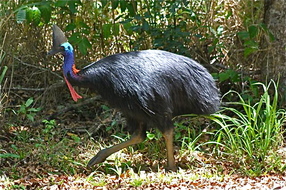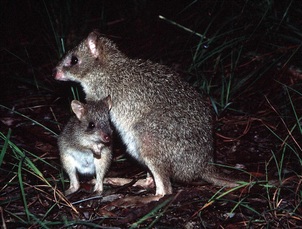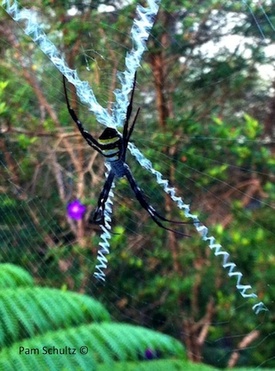Wildlife
Kuranda is located at one of the narrowest necks in the World Heritage listed Wet Tropics of Far North Queensland. The Kuranda area includes wet tropical rainforest, wet schlerophyll forest, and drier open forest, all in close proximity. (See Vegetation Map)
This diversity of habitat means that there is also a diversity of wildlife in the area.
This diversity of habitat means that there is also a diversity of wildlife in the area.
|
Southern Cassowary
The Kuranda rainforest is home to one of the few remaining populations of the endangered Southern Cassowary (Casuarius casuarius). This large, iconic bird is rarely seen, but has a huge impact on the continuity of many rainforest species, as it is in many cases the main distributor of their seeds. Urbanisation and fragmentation of habitat are putting pressure on the remaining population of Cassowaries in the Kuranda area. |
|
Northern Bettong
The wet schlerophyll forest, dominated by the huge straight trunks of Rose Gums (Eucalyptus grandis) and with a more open understorey, is home to a different range of animals. Among these, the Northern Bettong (Bettongia tropica) is one of the rarest and most endangered. This small (1.5kg) nocturnal marsupial was thought extinct for over 30 years until rediscovered in the 1970′s in just three locations, one of these being the Lamb Range near Kuranda. Bettongs have long claws that help them dig up the truffle-like fungi that are their main source of food. For more information, see the Bettong article. |
|
Northern Quoll
The Northern Quoll (Dasyurus hallucatus) is one of two quolls, possum sized marsupial carnivores, found in Far North Queensland. This is the smaller of the two, weighing up to 900gm, while the Spotted Tail Quoll which is found in thick forest on mountains weighs as much as 7kg. The Northern Quoll has white spots on the body, but not the tail, and lives in open forest in rocky areas close to water. Quolls are extremely aggressive when disturbed, and are famous for killing poultry. They do not have a true pouch, but a fold of skin covers the young quolls attached to the nipples. Quolls too are at risk as their habitat is lost. For more information visit the Quoll Seekers Network. |
|
Butterflies and other insects
Kuranda was once considered the butterfly capital of Australia. Australia’s largest butterfly, the female of the Cairns Birdwing, (Ornithoptera priamus euphorion) is common here, seeking out Aristolochia deltantha vines on which to lay her eggs. Another of the common species is the metallic blue and black Ulysses butterfly (Papilio ulysses joesa), which seeks out Euodia elleryana and E. bonwickkii trees to lay their eggs, maintains a looping path through the rainforest, often following creeks. The rainforest is host to an incredible number of insects, with often a different fauna in adjacent trees. (See also –Things that Bite and Sting) The St Andrews Cross (Argiope keyserlingi) spider (left) builds a decorative zig-zag cross over the centre of its web where the female sits and waits for her prey. Like other spiders, the male's body is only 3 - 6 mm long compared to the female that is 10 - 16 mm long. |




